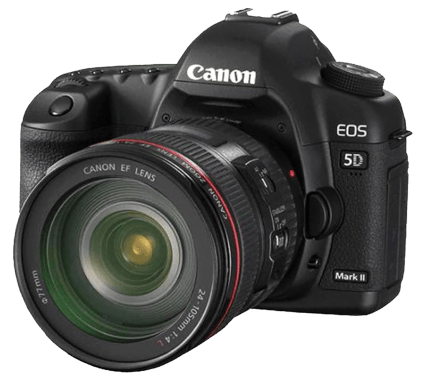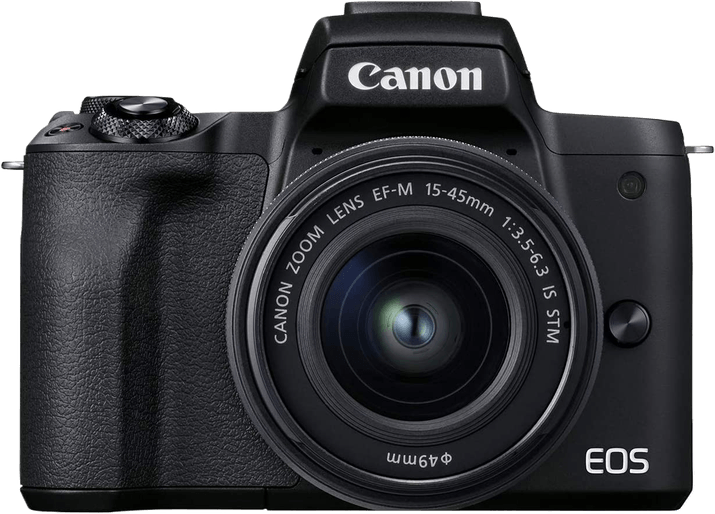Canon EOS 5D Mark II vs EOS M50 Mark II Comparison
Canon EOS 5D Mark II

Canon EOS M50 Mark II

The Canon EOS M50 Mark II wins by a slight margin with a score of 59/100 compared to the Canon EOS 5D Mark II‘s score of 58/100. Both cameras have their unique features and cater to different photography enthusiasts.
The two cameras share some similarities, such as their brand and announcement years. The 5D Mark II, a DSLR camera, was released in 2008 and has a launch price of $2199, whereas the M50 Mark II, a mirrorless camera, was launched in 2020 with a price tag of $750.
The 5D Mark II outshines the M50 Mark II with its larger size (152 x 114 x 75mm) and heavier weight (850g / 1.87lbs), which may offer better stability for certain photography styles. On the other hand, the M50 Mark II has a more compact design (116 x 88 x 59mm) and is significantly lighter (387g / 0.85lbs), making it a more portable and travel-friendly option.
Taking all these factors into consideration, the M50 Mark II is the winner due to its modern technology, compact size, and lighter weight. However, the 5D Mark II still holds its ground as a reliable DSLR camera for those who prefer its larger size and sturdier build.
Canon EOS 5D Mark II vs EOS M50 Mark II Overview and Optics
The Canon EOS 5D Mark II and Canon EOS M50 Mark II both score 59/100 in our optics comparison. Despite having the same score, each camera has its own strengths and weaknesses in terms of optics.
Both cameras share some specs, such as having a CMOS sensor, no image stabilisation, and similar megapixel counts (21 for the 5D Mark II and 24 for the M50 Mark II). Their processors differ, with the 5D Mark II featuring a Digic 4 and the M50 Mark II a more advanced Digic 8.
The 5D Mark II excels in sensor size and DXOMARK score. Its full-frame sensor provides a larger surface area for capturing images, which can result in better image quality, particularly in low-light conditions. Additionally, its DXOMARK score of 79 is significantly higher than the M50 Mark II’s score of 58, indicating superior overall image quality.
On the other hand, the M50 Mark II outperforms the 5D Mark II in shooting speed and lens mount. With a shooting speed of 10 frames per second, it is more than twice as fast as the 5D Mark II’s 3.9 fps. This makes the M50 Mark II more suitable for action photography. Furthermore, its Canon EF-M lens mount allows for a more compact and lightweight system, making it more portable than the 5D Mark II with its Canon EF lens mount.
In comparing the optics of these two cameras, the 5D Mark II offers better image quality with its full-frame sensor and higher DXOMARK score, while the M50 Mark II provides faster shooting speeds and a more portable lens system. Depending on the user’s needs and preferences, each camera has its own advantages in the realm of optics.
Canon EOS 5D Mark II vs EOS M50 Mark II Video Performance
The Canon EOS M50 Mark II outperforms the Canon EOS 5D Mark II in video capabilities, scoring 91/100 compared to the latter’s 43/100. Both cameras share some specifications, but the M50 Mark II has superior features that contribute to its higher score.
Both cameras can record video, but the M50 Mark II offers 4K resolution (3840 x 2160) while the 5D Mark II only has Full HD (1920 x 1080). This means that the M50 Mark II captures videos in a higher quality with more detail. Additionally, the M50 Mark II has a maximum video frame rate of 120fps, allowing for smoother and more dynamic footage, whereas the 5D Mark II is limited to 30fps. The M50 Mark II also comes with built-in time-lapse functionality, which the 5D Mark II lacks.
There are no specific areas where the 5D Mark II surpasses the M50 Mark II in terms of video capabilities. However, it is worth noting that the 5D Mark II has been a reliable and well-regarded camera for years, even though its video features have now been surpassed by newer models like the M50 Mark II.
Given the clear advantages of the M50 Mark II, it is the better choice for those prioritizing video quality and features. The 4K resolution, higher frame rate, and time-lapse functionality make it a more versatile and capable camera for capturing video. In contrast, the 5D Mark II, while still a solid camera, falls short in these areas and may not be the best choice for videographers.
Canon EOS 5D Mark II vs EOS M50 Mark II Features and Benefits
The Canon EOS M50 Mark II wins the features comparison with a score of 70/100, while the Canon EOS 5D Mark II scores 54/100. Both cameras share some common specifications, such as a 3-inch screen size, no GPS, and WIFI capabilities.
The M50 Mark II outperforms the 5D Mark II in several aspects. It has a higher screen resolution of 1,040,000 dots, compared to the 5D Mark II’s 920,000 dots. The M50 Mark II also has a touchscreen, making it easier to navigate menus and settings. Additionally, it features a flip screen, which is useful for shooting from different angles and for vlogging purposes. The M50 Mark II also includes Bluetooth connectivity, allowing for seamless pairing with compatible devices.
The 5D Mark II, however, has no significant advantages over the M50 Mark II concerning features. Both cameras lack GPS, and while the 5D Mark II has WIFI, the M50 Mark II also possesses this capability, along with additional features.
Considering the features, the Canon EOS M50 Mark II is the clear winner, offering a higher screen resolution, touchscreen, flip screen, and Bluetooth connectivity. These enhancements make it more versatile and user-friendly compared to the Canon EOS 5D Mark II. On the other hand, the 5D Mark II does not surpass the M50 Mark II in any specific feature. Therefore, the Canon EOS M50 Mark II is the better choice for users seeking a camera with more advanced features.
Canon EOS 5D Mark II vs EOS M50 Mark II Storage and Battery
The Canon EOS 5D Mark II outperforms the Canon EOS M50 Mark II in storage and battery, with a score of 71/100 compared to 21/100. Both cameras lack USB charging and have different battery types: the 5D Mark II uses the LP-E6, while the M50 Mark II uses the LP-E12.
The 5D Mark II excels with its longer battery life of 850 shots and two memory card slots, accepting Compact Flash (Type I or II), UDMA, and Microdrive cards. This provides users with more storage options and increased shooting capacity.
On the other hand, the M50 Mark II has only one memory card slot, compatible with SD, SDHC, and SDXC (UHS-I) cards. Its battery life is significantly shorter at 305 shots. Despite this drawback, the M50 Mark II’s storage compatibility with commonly used SD cards may be a benefit for some users.
Considering these factors, the Canon EOS 5D Mark II is the superior choice for extended shooting and versatile storage options, while the Canon EOS M50 Mark II offers compatibility with widely available SD cards.
Canon EOS 5D Mark II vs EOS M50 Mark II Alternatives
Still not sure which Canon camera is right for you? Our recent buying guides on the best Canon mirrorless for video or the best Canon camera for beginners may help! Or, check out these recent camera comparisons for more inspiration:
